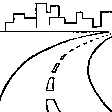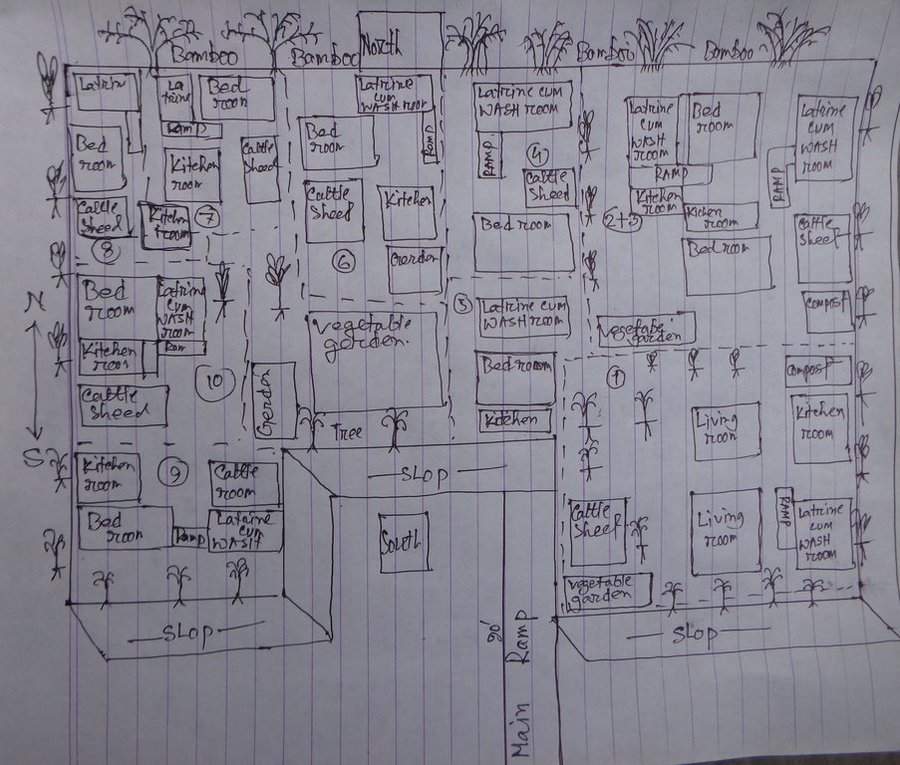



The inclusive, flood-resilient cluster village was introduced in a rural area with a high risk of recurring monsoon floods. The purpose of the technology is to provide safe housing, safe shelter for livestock, food security and income generation for ten families, including persons with disabilities.
The main components of the technology are:
1) The raising of a piece of land by seven feet (213cm), to three feet (91cm) above expected highest flood levels. Solid soil was banked up to encircle a 30'000 square feet (roughly 50x57m) piece of land and then the space within was filled up with sand collected from a nearby river bank. A one-foot layer of solid soil was added to cover the entire area.
2) The protection of the raised land from soil erosion during floods by planting a combination of deep-rooted fruit- and medicine trees around the border of the raised land. The trees include a number of different types of deep-rooted and light-rooted fruit trees and one type of medicine tree, Azadirachta Indica, locally known as "Neem". In addition, the slope of the border area was covered by grass turf to protect the soil from being washed out by rain. Two types of deep-rooted and flood resistant grasses were used. A drainage system was installed to facilitate water runoff.
3) The planting of a 150 square feet (14m2) commonly used homestead vegetable garden at the center of the cluster village. The cultivated vegetables include red spinach, jute leaf, basella leaf, spinach, radish, cabbage, okra, bottle-guts, cucumber and beans, allowing for a summer and a winter harvest. Together with the fruit trees, the vegetable garden provides food security during prolonged flooding. They also provide improved nutrition and income generating opportunities through selling of a part of the harvest in the market.
4) Making the village accessible for persons with disabilities through different accessibility measures, including the construction of a ramp, connecting the cluster village entrance with the road, and of accessible common Water-, Sanitation- and Hygiene (WASH) facilities, including a latrine, deep bore hole water source and water storage tank.
5) Installation of a solar panel to ensure uninterrupted, flood-resilient power supply. The level of power supply is sufficient to ensure coverage of electricity needs during flood season, when regular supply is around 15% below annual average.
The Cluster village was constructed as part of a disaster risk reduction project by CDD (Center for Disability in Development) from Bangladesh, with the support of CBM (Christoffel Blindenmission), an international development organization and funded by a donor from Germany. The main cost for inputs were provided to the land users by the project, including rent of construction machinery, paid labor, soil and construction material for the ramp and WASH facilities. The land users contributed labor and seedlings for the planning of the border trees and the homestead vegetable garden.
The main benefits of the technology from the perspective of land users are the protection it provides for houses and livestock, which would otherwise be in danger of loss during floods. The availability of food, water and electricity allows land users to remain in their homes during floods and avoid evacuation and the risk associated with it, including for example protection risks or the risk of theft. The flood protected vegetable gardens and fruit trees provide a year-round, sustainable source of food and income, providing food security and improved nutrition. The Neem tree provides medical and hygiene uses of the branches and leaves.
The cluster village is used as a safe space for the land users and other members of the community and their livestock during floods. Land users who are persons with disabilities or elderly benefit from the accessible infrastructure. With multiple families sharing land, the cluster villages provides optimal utilization of land resources. An additional benefit mentioned by land users is that the joint use by multiple families led to a more progressive social culture.

Localização: Horipur Union, Sundargonj Sub district,, Gaibandha District, Bangladesh
Nº de sites de tecnologia analisados: Local único
Difusão da tecnologia: Aplicado em pontos específicos/concentrado numa pequena área
Em uma área permanentemente protegida?:
Data da implementação: 2016
Tipo de introdução







| Especifique a entrada | Unidade | Quantidade | Custos por unidade (Bangladeshi Taka) | Custos totais por entrada (Bangladeshi Taka) | % dos custos arcados pelos usuários da terra |
| Mão-de-obra | |||||
| Land raising, tree planting and turfing on slope | person days | 290,0 | 300,0 | 87000,0 | 10,0 |
| Ramp construction | person days | 115,0 | 350,0 | 40250,0 | 10,0 |
| House reconstruction and WASH facilities | person days | 200,0 | 400,0 | 80000,0 | 10,0 |
| Solar system installation | person days | 10,0 | 300,0 | 3000,0 | 10,0 |
| Equipamento | |||||
| WASH equipment (latrine, magic pump, water tank, pipes, switch, pillars and other) | pieces | 10,0 | 46658,0 | 466580,0 | |
| Solar system | pieces | 10,0 | 6300,0 | 63000,0 | |
| Material vegetal | |||||
| Deep rooted trees | pieces | 100,0 | 40,0 | 4000,0 | 100,0 |
| Seed for vegetable | KG | 5,0 | 1000,0 | 5000,0 | 100,0 |
| Sapling purchase | pieces | 100,0 | 50,0 | 5000,0 | 100,0 |
| Light rooted tree | pieces | 60,0 | 30,0 | 1800,0 | |
| Fertilizantes e biocidas | |||||
| Organic fertilizer (compost) | KG | 600,0 | 10,0 | 6000,0 | 100,0 |
| Material de construção | |||||
| Rent for shallow machine for sand extraction | Daily rent | 10,0 | 28800,0 | 288000,0 | |
| Grass turfing | square feet | 15000,0 | 10,0 | 150000,0 | |
| Allowance for house reconstruction material | House | 10,0 | 2000,0 | 20000,0 | |
| Ramp construction | Piece | 1,0 | 125750,0 | 125750,0 | |
| Outros | |||||
| Project management (monitoring and support) | persons-days | 180,0 | 2400,0 | 432000,0 | |
| Custos totais para a implantação da tecnologia | 1'777'380.0 | ||||
| Custos totais para o estabelecimento da Tecnologia em USD | 22'217.25 | ||||
| Especifique a entrada | Unidade | Quantidade | Custos por unidade (Bangladeshi Taka) | Custos totais por entrada (Bangladeshi Taka) | % dos custos arcados pelos usuários da terra |
| Mão-de-obra | |||||
| House repairs | person days | 10,0 | 300,0 | 3000,0 | 100,0 |
| Ramp repairs | person days | 10,0 | 300,0 | 3000,0 | 100,0 |
| Plingth raising and plantation | person days | 30,0 | 300,0 | 9000,0 | 100,0 |
| Solar system servicing by technical experts | piece | 10,0 | 500,0 | 5000,0 | 100,0 |
| Material vegetal | |||||
| Seed for vegetable gardening | KG | 5,0 | 1000,0 | 5000,0 | |
| Material de construção | |||||
| Soil for slope maintenance | square feet | 5000,0 | 10,0 | 50000,0 | |
| Sand for slope maintenance | KG | 5000,0 | 2,0 | 10000,0 | |
| Custos totais para a manutenção da tecnologia | 85'000.0 | ||||
| Custos totais de manutenção da Tecnologia em USD | 1'062.5 | ||||
Fruit and vegetable production increased after introduction of the cluster village. Because of decreased loss of home and property during floods, labor is freed for crop production which increased overall crop production in the wider area.
Fruit and vegetable quality is improved because of availability of Irrigation.
Livestock mortality rate is reduced because of safe space in Cluster village.
Homestead vegetable garden and fruit tree plantation above flood level has a significantly reduced risk of production failure.
The flood-protected homestead vegetable garden allows for higher product diversity.
Increased availabilty of flood protected land for vegetable gardening.
Energy supply was not available before installation of solar panel.
Installation of deep tube well water source.
Significantly higher water quality during flood, because of flood protected water source in cluster village.
Installation of deep tube well water source.
Irrigation available to land users after installation of deep tube well.
Demand for irrigation water increased because of vegetable garden.
Increase of farm income through selling of fruit and vegetables.
Additional income source through selling of fruit and vegetables.
Decreased income disparities between the land users of the cluster village due to fruit and vegetable production available to all land users, Decrease income disparities between land users of the cluster village and other members of the communty because of the reduction of loss from flood damage.
Somewhat increased workload for maintenance of technology but decreased because of avoidance of damaged from floods.
Increased food security through flood prodected homestead garden and tree plantation.
Higher attendance of health workers because the cluster village offer suitable group meeting rooms and accomodation. Cluster village was constructed in vicinity of community clinic. Better hygiene through WASH facilities.
The cluster village is a suitable meeting point for the entire community, for social gatherings or festivals.
Cluster village offers common space for children and other land users for Joint recreational activities.
Much improved situation for persons with disabiltiies who are part of the land users. All persons with disabiltiies in the wider community use the cluster village as a safe space during floods. Improved situation for all land users who are from marginalized parts of society (daily laborers and share croppers).
Soil erosion during floods decreased because of deep- and light-rooted border tree plantation.
Raised land as safe space above flood level.
Drought impact in summer season decreased because of Irrigation.
Cluster village provides additional safe space/shelter for the wider community.